
The Covid-19 pandemic has destroyed supply chains all over the world. The two waves over the past two years have caused many problems, commencing from procurement of raw materials to getting the finished product to the customer. However, at the same time, there have been a few learnings that can have long-term advantages for the industry
Logistics sector outlook for the year 2022
All Signals so far point toward growth in manufacturing & core-sector organizations. Demand for Logistics & Transportation will also have a comparable growth. The large shippers will look at lowering the risk in supplies by increasing the control they exercise on secondary transportation to make sure product availability at consumption centers. One good thing that came out of the pandemic is that it has quickened the adoption of technology. The drive for technology adoption by transportation & warehousing will continue to increase at an accelerated speed. The technology center will be around cloud-based solutions for the digitalization of the transportation process.
Learnings from the pandemic
One of the big changes has been the depletion of supply chain redundancy. For years, just-in-time manufacturing and the idea of Lean were popular among companies. But the pandemic has revealed that perhaps such concepts can no longer be sustainable.
One more learning from the pandemic has been the need for sustainability in the supply chains. An organization must be mindful of its environmental, social, and economic impact. A sustainable supply chain can help organizations lower their total carbon footprint, while at the same time optimizing their operations so that they can maximize their profitability and reduce their costs.
The adoption of technology has been another expansion due to the pandemic. Organizations are investing in technologies so that they can have end-to-end clarity of the entire supply chain.
Aftermath of the pandemic
As a result of the pandemic, a lot of small and medium organizations had to shut shop due to a lack of clients and government support. As such, enterprises are now finding that the supplier pool they had before is much smaller now. Only a few have survived both waves of the pandemic.
Additionally, there has been a clear increase in costs concerning raw materials and services. Fuel and manpower costs have seen a rise as well, which has increased operational charges for nearly every organization.
Government initiatives and expectations from the new year
The shipping and logistics cost is not predicted to ease anytime soon due to the demand-supply gap. However, the government has brought to focus the need to lower overall logistics costs from 14% to under 10% for the competitiveness of the economy. The expectation is, that there will be an extension of a large outlay on infrastructure creation, building & Improving large tracts of highways to facilitate road transportation, all of which uphold the logistics industry directly & indirectly.
Preparedness for future disruptions
The logistics sector is going through a transformation and consolidation, organizing the highly fragmented industry. The manufacturer/shipper has explained processes for disruption and recovery from them and the service provider is aware of the steps to be obeyed for self-protection & for maintaining safety concerning any future disturbance. Companies are using digital technologies to be more adaptable and agile and avoid late deliveries, and lack of visibility and control.
The Way forward
The next stage of productivity improvement is awaited to be delivered by the deployment of technologies to smoothen collaborative execution by integrating processes across the shipper & vendor organization to give end-to-end visibility & get better control through the transaction execution. One hopes that this will be acquired & cascaded rapidly by large organizations through their supply & logistics chain.
Almost all of the challenges are easier to manage with the help of 13SQFT.COM. It is a fully integrated solution that can improve your business's performance and future-proof your supply chain.
POSTED BY
Ishika Adhana
Digital Marketing Executive